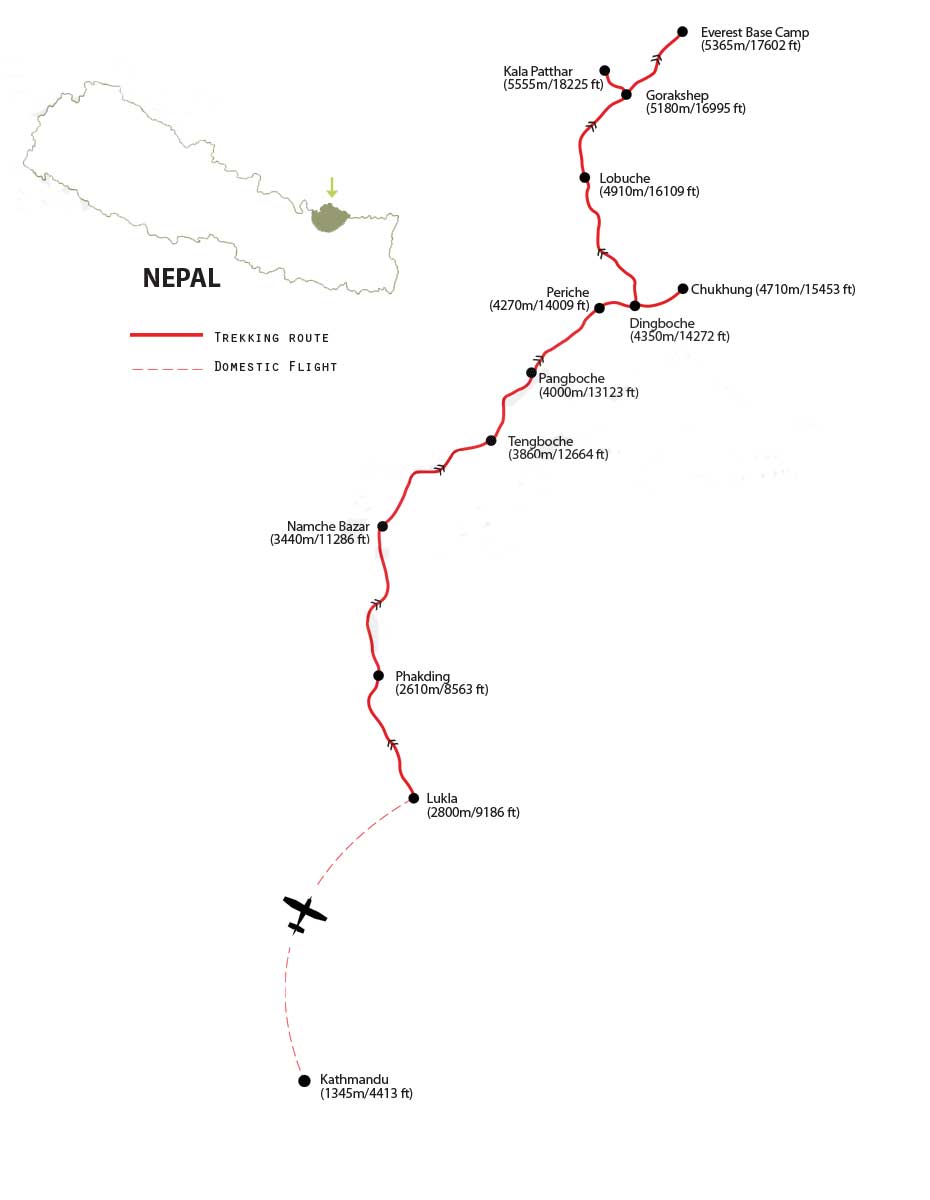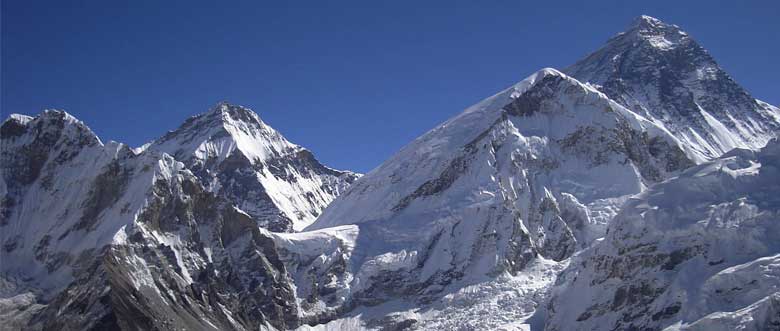
Following the footsteps of Hillary and Tenzing to the Greatest Mountain in the world! The ultimate challenge of Everest base camp trek offers breathtaking mountain panoramas, if you like to walk, this is one of the most inspiring places in the world to do it. Our Everest base standard camp trek is a great introductory lodge trek that offers sensational mountain views and an insight into the lives of the Sherpa people. After exploring the temples, shrines, bazaars and restaurants of Kathmandu we take an exciting mountain flight to Lukla and trek up the Dudh Kosi Valley, surrounded by the soaring peaks of Thamserku and Kusum Kanguru. It’s a steep ascent to Namche Bazaar, capital of the Kumbu Sherpas, where we are again greeted by spectacular mountain vistas. A rest day here aids acclimatization and there are great optional walks to enjoy the area. We then follow the trail to famous Tengboche, located high on a ridge where a magnificent 360-degree panorama awaits. The views of Everest, the Lhotse-Nuptse Wall, Ama Dablam and Kantega dominate this peaceful and spiritual location – surely one of the most tranquil and inspiring places in the world. While passing Buddhist monasteries, views of Everest get closer every day. This stunning trek visits both, Everest base camp and KalaPatthar (5555m), a viewpoint recognised as the best vantage point to see Mount Everest which is a premier goal for many adventurous walkers in the Himalayas. After trekking to base camp and Kalapatthar we return at our leisurely pace back to Namche and Lukla for our return flight to Kathmandu. For the more adventurous trekkers you have the option of returning over the Cho La pass to the Gokyo valley, and then ascending Gokyo Ri. Or if you are really fit, you can attempt the summit of Island peak. Our Everest base camp Group trek departs every week from Kathmandu, private trek can be arranged any time; view our selected departure dates Here . If our set departure dates are not convenient for you, you may choose Private departures by selecting your own convenient tour date. These types of departure are best suited to couples, families, charity and small groups of friends. Customized itineraries are available as per your travel need. Flight Delay in Kathmandu and Lukla The cost of the helicopter is payable directly to our Kathmandu office in the event that this service is utilized. US cash, traveler's cheques, or credit cards (Visa Cards, Master Cards only) are accepted. You will be given a receipt upon payment so that you may claim the amount from your travel insurance. The minimum cost will be US$500 and maximum US$3500 depending on the number of group members. Cost Includes What is the success rate for your trips?Trip Overview
Iteneary Details
Includes / Excludes
FAQ
Map
NOTE: During the trip; weather, local politics, transport or a multitude of other factors, that are beyond our control can result in a change of itinerary. It is, however, very unlikely that the itinerary would be substantially altered; if alterations are necessary the leader will decide what is the best alternative, taking into consideration the best interests of the whole group. Where a change does occur, we do everything we can to minimize its effect, but we cannot be responsible for the results of changes or delays.
Twin Otter is the primary mode of transport to and from the airstrip at Lukla. This service is fairly dependable. Sometimes, flights (to and from Lukla) may be cancelled due to mountain weather conditions or technical problems. In such case, Himalayan Trail Blazer will charter a helicopter to ensure you are on schedule for your international flight. The helicopter can fly if the visibility is 1500m, while the twin otter can fly if the visibility is 5000m, as per Nepal’s Civil Aviation rules.
Read more 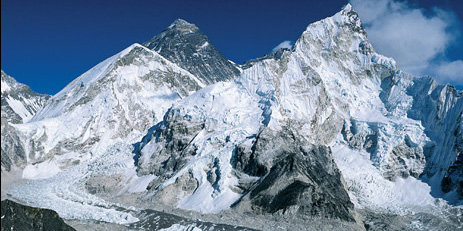 1. Day: Arrival in Kathmandu, 1300 m, and transfer to Hotel. Welcome and Breifing from Guide who will accompany you through out your stay in Nepal.
1. Day: Arrival in Kathmandu, 1300 m, and transfer to Hotel. Welcome and Breifing from Guide who will accompany you through out your stay in Nepal.
2. Day: Sightseeing program in capitalcity,Kathmandu through a culture/cityguide. Innumerous Temples, Palaces and Pagodas and the living tribes in Bazars are witness of a city between middleera and mordern time. The day you would be fascinated by the holiest of all Hindu Tempel in Nepal, Pashupatinath (open crematorium)and the largest buddist Stupa of Boudhanath. After lunch a visit to city of fine arts, Patan would make your day with its impressive work of handicraft from middleera.
3. Day: Flight to Lukla, 2800 m, where your porters takeover your luggage and set off. Maniwalls, Chortens and small sherpa settlements along the trail leads you following DUDHKOSHI, to Phakding, 2660m. [Walking distance 3 hrs]
4. Day: Namche Bazar, 3450 m,is capitalcity and important trading center of Sherpas.The trail follows DUDHKOSHI leaving behind few suspension bridges to Monjo, 2800 m where your guide makes sure you get a permit at SAGARMATHA NATIONAL PARKs entrance. The trail follows Jorsalle to Larja Dobhan. After crossing the Hillary Bridge the trail gets steeper upwards. If the weather is on your favor, the first sight of Mt. EVEREST (8848 m) from halfaway up to Namche. Today onward you find yourself in 'inner Himalaya' and is sorrounded from 6, 7 and 8 thousand meter mountains of Khumbu Himal. [Walking distance 5-6 hrs]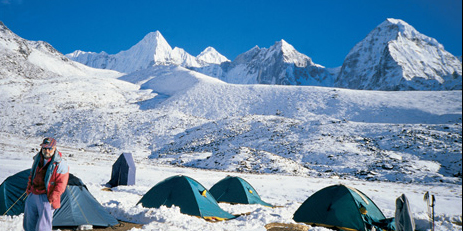 5. Day: Most important for acclimatisation is, you should not ascent very fast. Therefore, the acclimatisation day around Namche or to Syangboche and Everest View Hotel, 3900 m with a breathtaking view of Mt. Everest, Amadablam and other mountains is a very important part of whole trek. Later a cup of coffee at the bakery in Namche with superb views of himalaya or shopping some souvinour would add some good memories to your tour.
5. Day: Most important for acclimatisation is, you should not ascent very fast. Therefore, the acclimatisation day around Namche or to Syangboche and Everest View Hotel, 3900 m with a breathtaking view of Mt. Everest, Amadablam and other mountains is a very important part of whole trek. Later a cup of coffee at the bakery in Namche with superb views of himalaya or shopping some souvinour would add some good memories to your tour.
6. Day: The most beautiful trail to Tengboche, 3800 m, follows panorama trail from Namche to a tiny Sherpa settlement of Sagnasa, 3600 m with magnificant view of Mt. Everest, Amadablam(6856 m), Thamserku(6808), Khang-teka (6800 m), Tabuche (6363 m). Descend down to Phungi Tenga (3200 m). The trail thenafter gets steep upward to Tengboche through Pine and Rodhodendron forest with a glimpse of Thamserku and Khangteka the whole time. The Monastery in Tengboche is the largest and most believed by locals in the whole region. Being destroyed twice before, the new Tengboche Monastery offers education in Buddhism along with other faculties to monks. Sunset view on Everst, Lhotse, Nuptse and Amadablam (depending upon weather condition) is truely a view one would never forget. [Walking distance 6 hrs]
7. Day:Â Dingboche, 4400 m, is the highest settlement in Khumbu. The trail from Tengboche descends through dense Rodhodendron forest to Deboche. After crossing a metal bridge over Imja Khola, the trail goes up towards Pangboche, 3980 m with roundtheclock view of Amadablam.Visit Pangboche Gompa(optional) or maybe turn yourself the huge Mani inside the monastery. High dry stonewalls protects Potato fields from herds of mountain goats called 'THAR' living in the high lands of Khumbu.The Landscape changes. Instead of dense pine and rodhodendron forest, the vegetation gives a sense of alpine climate with juniper bushes and dwarf rodhodendron plants. You are now in the home of Snowleopard seen seldom when they come down to lower altitude in search of food. Two nights in Dingboche.[Walking distance 5 hrs]
8. Day: Acclamatization is now first compulsory exercise to be done. This day you would climb Nakartsang, 5300 m with a fantastic views of Mountains including Mt. Makalu (8463 m). If you find difficulty going up all the way, our staff will accompany you back to Dingboche. Lhotse, Nuptse und the Ama Dablam are one of you by now. Tiny Kharkas (Alms) and Yakpastures are situated everywhere and gurling Imja Khola never stops nearby.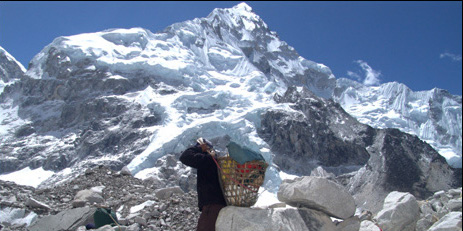 9. Day: The Trail to Lobuche, 4930 m, takes you to outlet of Khumbu Glaciar via Dhugla, 4600 m. Taking a short rest at Memorial site for those who died on Mt. Everest above Dhugla with mountain views all around makes you feel very spiritual. One could not just pass the site by without paying respect to those who died on mountains. Although the acclimatisation days in Namche and Dingboche helps you keep cope with altitude, it is always very important to drink a lot, ascend slowly but steady and never overstrain yourself. Step by step you come near the icy heart of Khumbu. Following the classic Expedition trail, finally you reach lodge in Lobuche. [Walking distance 6 hrs]
9. Day: The Trail to Lobuche, 4930 m, takes you to outlet of Khumbu Glaciar via Dhugla, 4600 m. Taking a short rest at Memorial site for those who died on Mt. Everest above Dhugla with mountain views all around makes you feel very spiritual. One could not just pass the site by without paying respect to those who died on mountains. Although the acclimatisation days in Namche and Dingboche helps you keep cope with altitude, it is always very important to drink a lot, ascend slowly but steady and never overstrain yourself. Step by step you come near the icy heart of Khumbu. Following the classic Expedition trail, finally you reach lodge in Lobuche. [Walking distance 6 hrs]
10. Day:Â Kala Pattar, 5545 m, towers above the icy highland. Fantastic view of Mt. Everest, Nuptse, Lhotse and other mountains which also marks the boarder to Tibet. You enjoy the breathtaking view as much you could before you descent down to highest accomodation of entire trekking to lodge in Gorakshep, 5200 m. A cup of warm Tea and Soup would make you feel better after accomplishing the days goal, Kalapatthar. Roll yourself in your sleeping bag earlier since the next day you would set off quite early for Everest Basecamp. [Walking distance 6-7 hrs]
11. Day: Everest-Basecamp, 5400 m, an excursion in the legends of Greatest Expeditions. The trail along the mightly Khumbu Glaciar rewards always new and spectacular views. Whether its a tribute to Sir Edmund Hillary and Tenzing Norgay or to Mallory and Irvine who might have climbed Everest already in 1924? Also one could not forget the Sherpas and their capabilty without whom hardly any expeditions on the highest mountain on Earth would have succeeded. Descent down to Lodge in Lobuche, 4930 m. [Walking distance [8-10 hrs]
12. Day: The way back begins and decents along Khumbu Glaciar over the stream of Pheriche to wellknown village of Pangboche, 3980 m. [Walking distance 5 hrs]
13. Day: The trail back to Tengboche and further down to Namche catch up with DUDHKOSHI in Phungi Tenga. Following the Everest Highway backward you reach Namche, 3450 m quite good on time. Enjoy your evening in Sherpa capital. [Walking distance 5 hrs]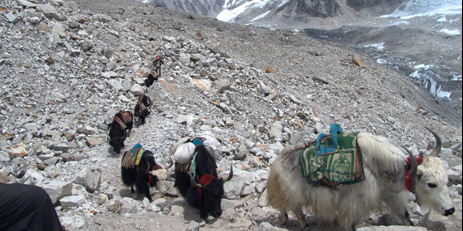 14. Day: Arrival in Lukla, 2800 m after crossing Hillary Bridge and walking pass village of Monjo where your guide will check you out of SAGARMATHA NATIONAL PARK. Farewell with trekking team. [Walking distance 6-7 hrs]
14. Day: Arrival in Lukla, 2800 m after crossing Hillary Bridge and walking pass village of Monjo where your guide will check you out of SAGARMATHA NATIONAL PARK. Farewell with trekking team. [Walking distance 6-7 hrs]
15. Day: Flight to Kathmandu, 1300 m normally take place early morning but depending upon weather it could delay. On arrival in Kathmandu, transfer to hotel.
16. Day: Sightseeing/Shopping, day in Kathmandu. One could go on optional Sightseeing on request.
17. Day: International Departure, official Farewell from Himalayan Trailblazer and transfer to International Airport.
Read more
- Airport / Hotel / Airport pick up & drop by private tourist vehicle.
- Standard twin sharing accommodation in a three star hotel in Kathmandu; Breakfast included. (4 nights)
- Guided city tour in Kathmandu by private tourist vehicle.
- All your standard Meals during the trek (Breakfasts, Lunches and Dinners).
- Lodges, Guesthouses accommodation during the trek (11 nights Trekking Guesthouse in twin sharing and occasionally dormitory style).
- Local Himalayan Trail Blazer licensed English speaking guide.
- The required number of local staff and porters to carry your luggage during the trek (We assign one porter for every two guests).
- Food, accommodation, salary, insurance, equipment and medicine for all staff.
- Everest National Park permits and TIMS permit for trekking.
- Down Jacket and sleeping bag by Himalayan Trail Blazer (which need to be returned after the trek).
- Airfare from Kathmandu – Lukla - Kathmandu including airport departure tax in Kathmandu and Lukla airport.
- Surface transfer from and to Kathmandu.
- Sightseeing/Monument entrance fees in Kathmandu (On Day 2).
- Farewell dinner in typical Nepali Restaurant with cultural dance show on second last day (On Day 15th).
- All our government taxes, vat, tourist service charges.
- Official expenses.
Cost Does not Include
- Lunch and dinner whilst in Kathmandu.
- Travel insurance which covers emergency Rescue and Evacuation.
- International airfare and airport departure tax.
- Nepal entry visa; you can obtain a visa easily upon your arrival at Tribhuwan International Airport in Kathmandu. (Tourist Visa with Multiple Entries for 30 days can be obtained by paying US $ 40 or equivalent foreign currency. Similarly, Tourist Visa with Multiple Entries for 90 days can be obtained by paying US $ 100. Please bring 2 copies of passport size photos).
- Alcoholic, hot and cold drinks.
- Personal trekking Equipment (See the trekking equipment page).
- Tips for trekking staff and driver (Tipping is expected).
- Any others expenses which are not mentioned on 'Price Includes' section.
Read more
We have up to 98% success rate for our Everest treks.
What type of shape do I need to be in, is this trip for me?
Everest base camp standard trek is suitable for average people who are moderately fit, thus no previous experience is required. Some physical fitness programs such as running, swimming, hiking is recommended before you embark on your journey. Whilst on the trek, it is common to experience some discomfort before being fully acclimatized.
To prepare for a strenuous trek you should begin training at least two to three months before your departure. As a guideline, an hour of aerobic exercise three to four times per week would be considered a minimum requirement. The best preparation is bushwalking involving relatively steep ascents and descents. If you can manage a couple of valley floor to ridgeline ascents per comfortable and able to enjoy the trek to the fullest. They are physically strong, sharp-witted and have an incredibly positive attitude towards a life that we would consider extremely tough. There is something about a trek in the Himalaya that draws you back time and time again. For keen walkers it is a paradise and even avowed non-walkers find that one foot just seems to follow the other, drawn by the appeal of what lies beyond.
Will somebody come to pick me up at the airport upon my arrival?
Yes, our airport representative will be there to greet you at the airport. S/he will be displaying an Himalayan Trail Blazer sign board outside the airport terminal. Upon arrival, you will be transferred to your hotel by our tourist vehicle.
What sort of accommodation can I expect in Kathmandu and in trekking?
We use standard rooms at three star hotels in Kathmandu with breakfast included. Along the trekking routes, teahouses/lodges generally provide basic clean facilities with a mattress and a quilt or blanket. We can also offer you Himalayan Trail Blazer sleeping bags if needed (to be returned after the trip) but it is a good idea to always have your own sleeping equipment.The lodges in trekking routes usually provide single and double rooms, or occasionally a dormitory. At times when possible, dining will be around a bon fire. In tea houses, food will be prepared in the kitchen which you should not enter without permission. The toilet in tea houses provides essential and basic facilities and are always outside the room.
Is it possible to reserve a trip now and pay deposit later or do I HAVE to pay deposit at booking/reservation?
Yes! The trip will be confirmed only when we receive the completed final booking form and 30% deposit payment. You can pay the balance of the money when you arrive in Kathmandu.
Is there a possibility of getting separate rooms for the Kathmandu portion of the trip? If so how much extra will this cost?
Yes! We can surely book separate rooms in Kathmandu for your portion of the trip. During the trek we will try our best but normally the lodges have twin sharing and dormitory styled room instead of a single room. The lodges will provide a private room for one person when the room is free and additional cost is not required.
The additional cost is USD 70 per person for booking a single room in Kathmandu for four nights when booking for groups of two or more than two people. For one person the trip price of USD 1800 per person already includes a single room supplement fee.
Is this a guaranteed departure even if I am alone stating in the request trip?
YES all our trips are guaranteed to run. We never cancel the trip due to not having enough participants, we can arrange the trip for one person as well.
When I pay the remainder of the money on arrival in Kathmandu, how do you take that money? US cash or credit card?
You can clear the remainder of the money upon your arrival in Kathmandu or even before you arrive in Kathmandu. You can use USD cash, American Express, Travelers Check, Master or Visa cards for the payment options. There will be 4% bank levy when paying by credit cards.
What sort of food can I expect in trekking?
Most teahouses (lodges) in Everest Base Camp trails cook a delicious range of mostly vegetarian fare. Pasta, tuna bakes, noodles, potatoes, eggs, daal bhat(rice and lentils), bread, soup, fresh vegetables (variety depends on the season) and even some desserts like apple pies, pancakes, and some interesting attempts at custard. You will find a lot of garlic on the menu because it assists with acclimatization – eat some every day. In many larger villages you may find some meat items on the menu. You can always get hot chocolate, tea, and hot lemon drinks, as well as soft drinks, and treats like chocolate and crisps. Each day dinner and breakfast will be at a lodge you'll stay at while lunch will be taken on the way to destination.
Is the food in mountain prepared to international standard in terms of safety?
YES, the food is very safe during the trekking and we recommend you to eat the vegetarian and local food.
Is water provided and is there still water available at higher altitudes? Is it filtered/boiled? Readily available?
Bottled water is easily available at the lodges and tea houses. You can buy bottled water at the cost of USD 2 at lower elevations to USD 4 to higher elevation per littler. You can also drink the normal tap or spring water if you bring the purifying aid with you.
What mode of transportation do you use?
Himalayan Trail Blazer is all about providing you with local insights, lifestyle as well as adventure. Depending on the nature of the travel, the transportation to and from the destination varies from domestic flights to vehicular transportation to even piggyback rides on mules and yaks. We provide you only those options which enhance your local experience while allowing you to travel comfortably and efficiently. We use private tourist vehicles for sightseeing, city tours and pickups. Depending on the group size we use cars, minibus, vans or alternatively 4WD SUVs, more maneuverable in travelling along the narrow and bumpy roads of Nepal. All the vehicles are usually air-conditioned unless we are travelling in cooler areas.
For domestic flights (Kathmandu - Lukla - Kathmandu), we use Tara Air, Agni Air -popular domestic airlines.
What is the best season for this trekking?
Our trekking season extends from mid- September to May. From early September the monsoonal rains decrease. By end of September through to December the weather is usually stable with mild to warm days, cold nights. February, March, April, May, October, November, December are the best time to do Everest base camp trek.
What is the weather and temperature like in trekking?
Every trekking trip up the mighty Mt. Everest presents its own amazing, unforgettable moments that forever live on in the hearts and minds of those brave enough to make the climb. One of the most unpredictable elements of the Everest region is the weather. If you’re not properly prepared for the twists, turns and volatility of the conditions that can occur in this breathtaking region, you might find yourself in an uncomfortable and unpleasant situation. Here are some weather basics to help ensure that you come to the Himalayas as well equipped and prepared to face anything.
Generally speaking, the nights are much cooler than the daytime hours in the Everest region. Many first-time trekkers are surprised to learn about the incredible range that may occur in a given day. During the day, the thermometer could reach temps as high as 25 degrees C, only to dip down as low as -20 degrees C in less than 24 hours. While there’s no way to know exactly what each day in the mountains will bring, the weather and temperature ranges tend to be somewhat predictable based on the month and season.
Spring - March / April / May / June
Spring happens to be one of the best times of the year to visit the Everest region, although because of this, it can become somewhat crowded. One can meet many other Everest climbers during this season and base camp is full of tents. The beautiful clear blue sky can be seen and the many different species of flower are visible in the lower altitude.
During springtime, the average temperature is 17 degrees C with a maximum of 25 degrees C during sunny days and a minimum of -15 degrees C in the morning and at night for areas above 4000 meters.
July / August Through Mid-September is Monsoon Season
This season is not really recommended to travel as it rains in the lower altitudes, below 3500 meters. In areas above 4000 meters, it rains sometimes and although it is also sometimes dry, very few people travel during this season. There are positives to trekking during the monsoon months, however. The excess rainfall can provide ample chance to see spectacular views of the waterfall and it’s also the best season to avoid the crowds. The maximum temperature during the monsoon season averages 25 degrees C during sunny days with a minimum -15 degrees C in the morning and night at areas above 4000 meters. The average temperature tends to hover around a comfortable 18 degrees C.
Autumn - End of September / October / November
Similar to springtime, autumn in the Everest region is also a crowded season, but it’s one of the best times to trek. While it lacks the beauty of flowers, the clear blue sky can be seen, affording incredible views from just about every angle.
The average temperature during the fall is 15 degrees C with a maximum temp of 20 degrees C during sunny days and a minimum of -10 degrees C in the morning and at night, for areas above 4000 meters altitude.
Regardless of time of year, trekkers should always plan accordingly and bring clothing for both cooler and warmer temps. Layering is always recommended, as are pants that can double as shorts. For a full list of clothing and materials to bring to account for various temperatures and weather changes that can occur in the Everest region, visitors should work closely with their travel provider. This will ensure that the adventure will be enjoyable no matter what the weather and that every possible scenario will be accounted for ahead of time.
I m a Vegeterain, is that a Problem ?
No problem at all because the lodges mostly serve the vegetarian meals. We always recommend our clients to eat vegetarian meals to avoid the food poisoning, eating heavy meals and non- vegetarian meals at the high altitude is not really safe for the stomach.
Do your guides have trekking guide certificates from the Hotel Management and Tourism Center? Have they received first aid training for high altitude?
Yes, they have all received a 45-day training from the Hotel Management and Tourism Center in Nepal. The guides have also received high altitude first aid training from KEEP (Kathmandu Environmental Education Project).
What safety measures are in place? What safety equipment do your guides carry with them on trek to deal with sickness/accidents?
Our guides are well trained for the high altitude problems and first aid. They always carry the first aid kit bag during the trek. However we still recommend you to bring your personal first aid kit as well. All our guides carry the local mobile phones and SAT phones for the emergency.
Do you know about how many miles the trek is?
Total distance of the entire trek is about 75 miles.
Do we book our own international flights to and from Nepal?
Yes, you need to book your own International flights. We are a local agent and it would cost you significantly higher to book through us.
Can I charge my digital camera or other equipments on my trip?
These facilities will be available in most of the places in your hotel reception by paying some service charges. Remember to bring TWO and THREE pin travel adapters!
Is there any communication while we are on trekking?
There are telephones in some villages along the trekking routes from which you can make international calls. All our guides are equipped with the local mobile phone. You may wish to pass the number of our guide to your family for the callback or you can make a call from the guide’s mobile and pay him directly for the international call too.
Can I use credit cards in the places I visit in trekking?
In the cities, yes - to some extent. Once you are out of the cities, all you need is cash. Please change the currency in local Nepali Rupees before you go to the mountains.
How much additional money do I need per day?
It depends on your spending habits. Generally, in Kathmandu, you can allocate USD 10 to USD 15 for a lunch and a dinner. USD 15 to USD 18 per person a day will be enough to buy bottles of water, chocolates, pay for the hot shower and a few drinks during the trekking.
Do I need to tip my guide and porters? How much would that be?
This is a difficult thing to gauge. We have seen everything from USD 20 to USD 1000 per person for guides and porters. Tipping is not required, but a small gesture of thanks to your guides and local porters. The level of the tip should reflect the level of satisfaction from and personal involvement with your guide. However, we recommend you to spend minimum 10% of your total trip cost for tipping entire local staffs, the ratio of tipping guide and porter will be given to you at the pre-trip meeting in Kathmandu before starting the trek.
What opportunities will I have for shower along the trek?
In major places (Namche Bazar, Lukla), we arrange guesthouse with hot shower. And in rest of the places, hotel water in bucket will be provided for shower; it would cost you extra about USD 3-4 per shower.
Is Himalayan Trail Blazer's staff insured?
Our company insures all our trekking staff members, including guides, cooks, Sherpas and porters.
Where do we toilet along the trail? Is it similar to Kilimanjaro and just wherever we can find privacy?
At most cases you can use the toilet provided by the tea houses/lodges on the trail but normally in case of emergency, you just do toilet along the trail wherever you find privacy.
Can I add extra days to my trekking trip?
Holiday should never be about making it to the final point quickly. Along your trek we can add days at your request with additional costs to cover guides, porters, accommodation and food.
Do you use yaks/porters on the trek or do we carry all of our own gear?
Whilst on the trek, our porter will take care of your luggage. All you need to carry is your small day bag for your personal belongings like camera, water bottle, sun cream etc only.
Will there be a place to store items/clothing not required for the trek?
The hotel in Kathmandu does provide the free storage services. So you can leave all your items that are not required for the trekking at your hotel.
What is the temperature rating of the sleeping bag that you lend to trekkers?
The temperature rating of the sleeping bags we provide are about -10 deg C, we can provide liner or extra blanket if the sleeping bag is not warm enough for you.
Do you guys have a PAC Portable Altitude Chamber?
Yes, we do have PAC but we don’t use it for Everest Base camp trek since you only have to stay a night above 5000 meters. We will surely provide one if required.
I would like to extend my holiday, any recommendations?
Yes, there are a plenty of options and choices to extend your holiday before or after your main trip.
Can I obtain the visa for Nepal upon on arrival at the airport?
YES, you can obtain a visa easily upon your arrival at Tribhuwan International Airport in Kathmandu. Tourist Visa with Multiple Entry for 30 days can be obtained by paying US $ 40 or equivalent foreign currency. Similarly, Tourist Visa with Multiple Entry for 90 days can be obtained by paying US $ 100. Please bring 2 copies of passport size photos.
What immunizations will I need?
No vaccinations are compulsory in Himalaya, but we do recommend you are covered for diphtheria & TB, hepatitis A, hepatitis B, *malaria, typhoid, polio and tetanus.
We also recommend:
A dental check-up prior to travelling.
That you know your blood group in case of emergency.
If you have any pre-existing medical conditions which might affect you on tour, you make these known to your tour leader and Himalayan Trail Blazer at the time of your booking.
Read more

